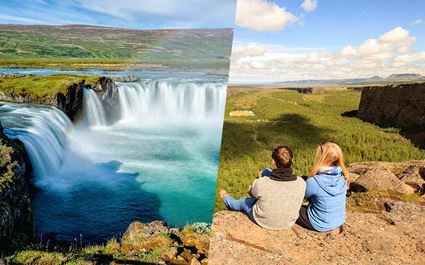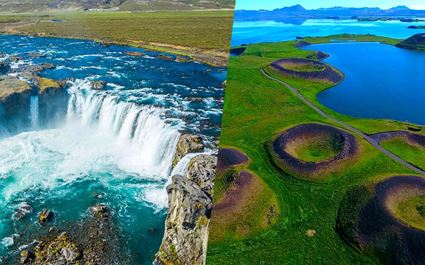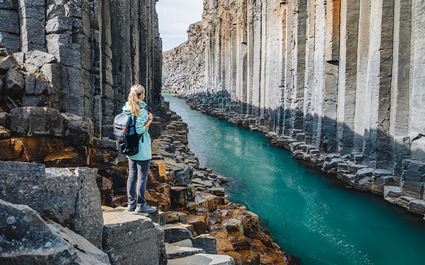Where Are Krafla Fields Located?
The Krafla Lava Fields are located in northern Iceland, about 480 kilometers (300 miles) from the country's capital, Reykjavík. The area is also 80 kilometers (50 miles) east of Akureyri, the largest city and cultural hub of North Iceland. Krafla is situated on a geological hotspot of the Mid-Atlantic Ridge, which forms the boundary between the North American and the Eurasian tectonic plates.

How To Get To Krafla?
The main way to get to Krafla Lava Fields is by car. The drive from Reykjavík takes about 6 hours. From Akureyri, the drive is around 1 hour and 30 minutes. The lava fields are just off the Ring Road, Iceland's main highway, which will take most of your journey. When you approach the area, turn onto the designated road leading to the lava fields - you won't miss it. The road to Krafla is well-maintained and easy to drive, but it is essential to be aware of the weather conditions, as the road can be icy during winter.
Once you arrive at Krafla Lava Fields, you can leave your car in one of the parking areas. There are many hiking trails that you can take to start exploring the lava fields. The trails range in difficulty from easy to moderate, so there is something for everyone.
General Information About Krafla Fields
- Location Northern Iceland
- Area Size 480 km² (185 mi²)
- Part of The Krafla volcanic system
- Accessibility Car
- Time to Visit Year-round
- Activities Sightseeing, hiking, photography
What Are Krafla Fields Known For?
Krafla fields are known for their unique and dramatic landscape, created by some of Iceland's most explosive volcanic eruptions. The lava fields belong to the Krafla volcanic system, home to various geothermal features such as hot springs, geysers, and fumaroles.
The area has unusual geological formations, including lava tubes, craters, and thermal vents. It's also full of vibrant colors, ranging from deep red and orange to pitch black. The different colors are products of the lava's composition and the time it has been exposed to the elements.
The fields are surrounded by mountains, lakes, and forests, creating an evolving mix of volcanic landscapes, geothermal features, and green vegetation. The area is a reminder of nature's power that has captivated visitors with its raw beauty for centuries.

History Of Krafla Volcano
The Krafla Lava Fields are a fascinating part of Iceland's geological history with frequent volcanic activity. The area's repeated eruptions over millennia created a unique and dynamic landscape we can witness today.
Early Eruptions
The first recorded eruption in the Krafla area occurred in 874, shortly after the first Norse settlers arrived in Iceland. The eruption produced a large lava flow that covered a vast area and destroyed several farms.
Over the centuries, Krafla continued to erupt at irregular intervals, creating patches of lava and craters. The most significant eruptions occurred in 1341 and 1724, producing lava flows that covered hundreds of square kilometers.
Mývatn Fires
The most famous eruption in Krafla's history is the Mývatn Fires, which lasted from 1724 to 1729. These eruptions were caused by the opening of fissure vents along the Krafla caldera, which released a torrent of lava, ash, and toxic fumes.
The Mývatn Fires devastated the surrounding area, destroying farms, forests, and livestock. The toxic fumes also caused widespread illness and death, and many people were forced to flee their homes.
Recent History
The most recent eruptions in Krafla occurred between 1975 and 1984, known as the Krafla Fires. These eruptions were smaller than the Mývatn Fires, but they still caused significant disruption to the area.
Such a history of outbursts led to the development of the Krafla geothermal power station in the area, which utilizes the heat from volcanic activity to generate electricity. The power plant has helped to reduce Iceland's reliance on fossil fuels, using natural resources to be a leader in renewable energy.

Interesting Facts About Krafla
Krafla is a highly active volcanic system and has erupted 29 times in the last 1,200 years. The most recent eruption was in 1984, and there is always a chance of future eruptions.
The Krafla Lava Fields have cultural significance for the Icelandic people. The area has been a source of materials for building and a place of spiritual importance for centuries.
The fields are a valuable site for science. Scientists study the area to understand the processes of volcanism and geothermal activity. The research conducted at Krafla helps to improve our understanding of the Earth's interior works, the potential for future eruptions, and geothermal energy production.
What To Do At Krafla Fields?
- Hike the Leirhnjúkur Lava Field: This is a short and easy hike that takes you through a variety of lava formations, including lava tubes, craters, and geothermal vents. The trail is well-maintained and easy to follow.
- Visit Víti Crater Lake: This crater lake is located within the Krafla caldera and is one of the most unique and popular attractions in the area. The lake is a vibrant blue color and is surrounded by steaming fumaroles.
- Explore the Krafla Geothermal Power Plant: The power plant uses the natural heat of the area's geothermal activity to generate electricity. The plant is open for tours, and visitors can learn how geothermal energy powers Icelandic homes and businesses.
- Visit Námaskarð Geothermal Fields: These geothermal fields are home to various hot springs, mud pots, and fumaroles. Visitors can walk among the steaming pools and enjoy the unique geothermal landscape.
Best Time To Visit Krafla Fields
Summer (June to August) is the busiest time to visit, as the weather is warm and sunny and has many daylight hours. This is an excellent time to hike, explore the geothermal features, and go stargazing if you don't mind the crowd.
Spring (April to May) and autumn (September to October) are good options for a peaceful experience. The weather is still pleasant during these months, and fewer tourists allow more space.
Winter (November to March) is the quietest time to visit, and the scenery is beautiful. The snow-covered lava fields are stunning, and the geothermal features are even more active.

Where To Stay Near Krafla Fields?
- Fosshótel Mývatn is located just outside of Mývatn, a popular tourist destination near the Krafla Lava Fields. The hotel offers a variety of amenities, including a swimming pool, sauna, and restaurant.
- Berjaya Iceland Hotels is also located in Mývatn, offering various rooms to choose from according to your budget.
- Hótel Laxá is located in Laxárdalur, a small village near the Krafla Lava Fields. The hotel has a variety of rooms on offer.
- Vogafjós Farm Resort is just a short drive from the Krafla Lava Fields. This welcoming farm stay offers a variety of activities, including horse riding, hiking, and fishing.
- Hlíð Camping and Guesthouse is a great option for campers, offering pitches for tents, campervans, and caravans. It's close to the lava fields and has hot showers and a communal kitchen










